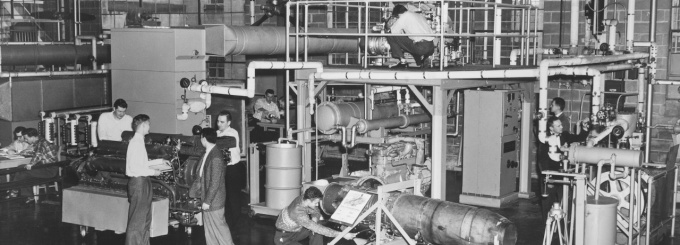Our History

CBE students conduct an experiment in the former engineering labs in the basement of Parker Hall on the South Campus
A short history of the department, by Thomas W. Weber
UB CBE Early History
UB was actually founded in 1846 as a school of medicine and then grew to become a sizeable university. The State University of New York at Buffalo was established in 1948, and UB was merged into SUNY in 1962. In those days, tuition was a mere $500 a year for undergraduates and $700 a year for graduate students. Joe Bergantz, a local consultant with considerable research and development experience in industry, was hired part-time to design a Chemical Engineering program for the School of Engineering. An outgrowth of this was the hiring of Don Brutvan, who became the first full-time faculty member in the Spring of 1961. In May, a formal announcement of our BS and MS programs was made. Joe came on as a full-time Professor and Chair, and Bill Mathewson, who had just completed his PhD at Cornell, was hired.
A new Chemical Engineering Building was to be built in the vicinity of Parker Engineering Building on the Main Street Campus. An architect drew up some beautiful plans for a 66,000 square-foot building with laboratories and classrooms. Earliest occupancy was planned for the middle of 1964. (As it turned out, the building was nothing more than a dream.)
The department's first full year of operation was 1961-62. Joe, Don, and Bill taught several courses to about 40 part-time graduate students. Ray Ewell, the Vice Chancellor for Research at UB, taught a special course in thermodynamics. In the second year, new sophomore and junior courses were offered to undergraduates and a PhD program was authorized. I was hired in January of 1963 to cover the newly emerging area of Process Control. I taught that course and the advanced mathematics course for graduate students in Chemical Engineering. It was a real test of endurance and a challenge to keep people awake on Tuesday and Thursday evenings. I would teach one of the courses from about 6:30 to 8:00, and the other from 8:30 to 10:00.
In the Fall of 1963, Dave Johnston joined us from the University of California. Our Graduate Program consisted of three evening courses that semester. Dave taught the course in Advanced Mathematics, Don gave a course in Phase Equilibria and Staged Operations, and I taught Transport Phenomena using a new book by Bird, Stewart, and Lightfoot. We were beginning to teach some undergraduate day courses as well. Each of us taught two courses each semester, and in most cases they were new ones which we had never taught before. We expected that we would finally graduate two MS and five BS students by the Fall of 1964.
Dave Johnston stayed on for only a year and then decided to go to divinity school -- sounds a bit unusual, but Dave's father was a minister. Bill Mathewson left to seek his fortunes in industry. Three new faculty joined in 1964, namely Ken Kiser, Harry Cullinan, and Bob Good. Sol Weller came on the next year. Most of the faculty were in Parker Engineering and a couple of us had offices and labs in Acheson Chemistry. In 1966, we finally got our own building -- not the one that an architect had drawn the plans for -- but a pre-fabricated, metal-walled “Butler” building that was set up between Acheson Chemistry and Parker Engineering. It housed our departmental offices, a huge open-bay area in the center for the Unit Operations Lab, Bob Heisler's shop, and small labs around the periphery for graduate students. Aptly named the “Chemical Engineering Building,” that building was a vibrant place! Some of the faculty had their offices in another nearby pre-fab building, Acheson Annex. Most of those offices were internal with no windows, but some of the external offices didn't have windows either. The Administration didn't want us to be distracted! One of the seniors -- I think it was George DiPirro -- took pity on Ken Kiser. He drew a picture for Ken to hang on his wall that showed what he would have seen if he had had a window!
New faculty were added in 1966-67 -- Julian Szekely, Ken O'Driscoll, Paul Ehrlich, and John Howell. In 1968, Joe went on a sabbatical to England and Sol Weller stepped in as Acting Chair. Upon his return, Joe became an Associate Dean and Harry Cullinan became the Chair. When Harry went on sabbatical in 1972, Sol again served as Acting Chair. In 1976, Joe unexpectedly passed away. Harry left to become the Vice President of Academic Affairs at the Pulp and Paper Institute in Appleton, Wisconsin. The Department was then under Acting Chairs for two years -- first Sol Weller, and then Ken Kiser. In the meantime, Bill Gill had joined the Engineering School as Dean in 1971, Eli Ruckenstein came in 1973 and Mike Ryan in 1976.
As we moved to the new campus in 1978, Jarda Ulbrecht arrived from England to become Chair. Carel Van Oss from Microbiology became an Adjunct member of the Department and has played an active role in the Department since then. Ralph Yang joined the Department shortly thereafter and Vladimir Hlavacek arrived in 1981. Jarda went on a leave-of-absence in 1982 and I became Chairman, a position I held for seven years.
Now we “fast-forward” to 1985. John Tsamopoulos joined us, and the next year, Carl Lund. Bill Gill, who had stepped down as Dean in 1976, left in 1987 to become Department Chair at R.P.I. In 1989, I was replaced as Chair by Ralph Yang. After six years, he left to become Chair at the University of Michigan. Ken Kiser, who had been Associate Dean of Engineering, returned to the Department full-time as Chair until he retired in 1997.